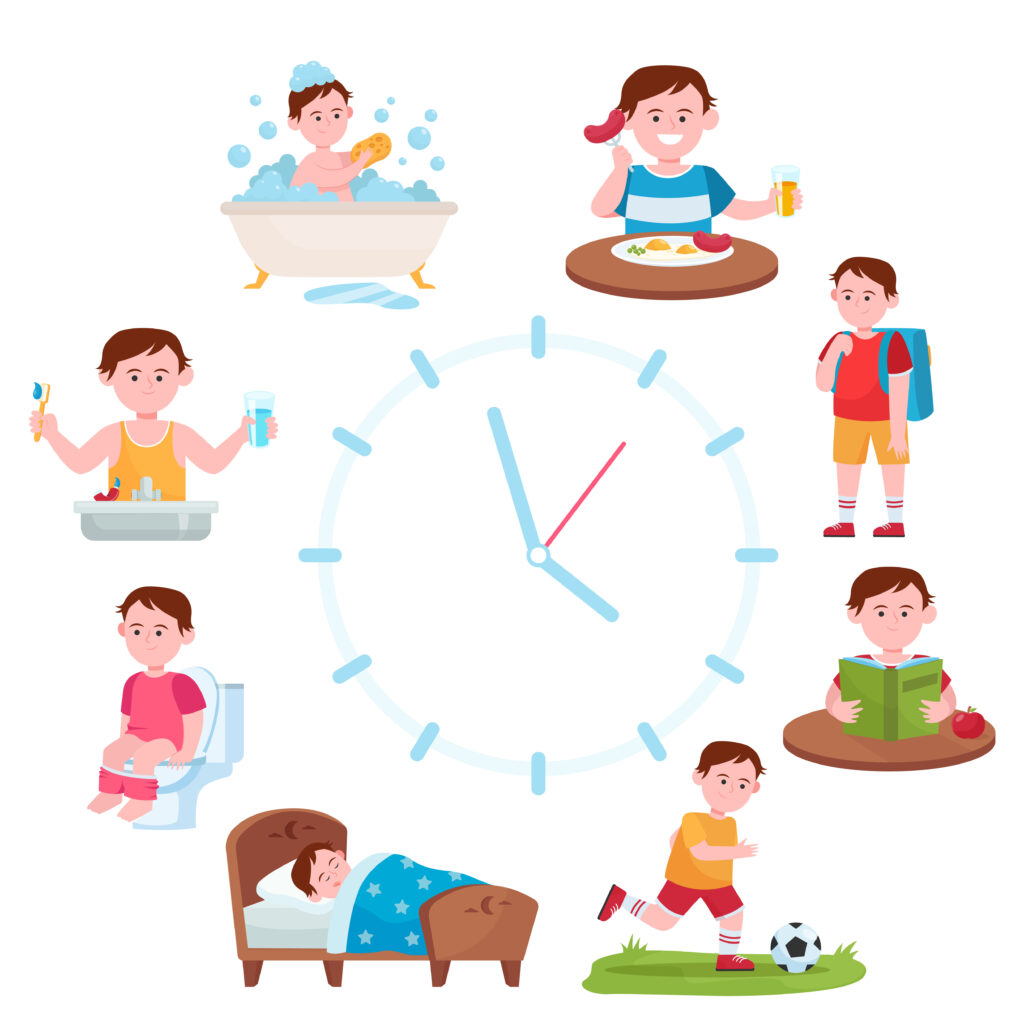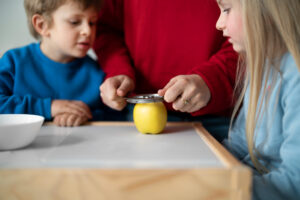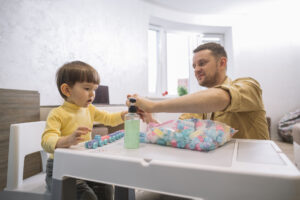
Creating Daily Routines with OT Support for Autistic Children
Daily routines provide structure, predictability, and safety. For many autistic children, routines are more than “nice to have” — they can reduce anxiety, ease transitions, support learning, and build independence. Occupational therapists (OTs) play a central role in helping families design, implement, and adapt routines that respect each child’s unique needs.
Why Routines Matter for Autistic Children
- Predictability reduces anxiety: Knowing what’s coming next (when breakfast ends, when school begins, when bedtime comes) makes the day feel safer and less overwhelming.
- Supports sensory regulation: Many autistic children have sensory sensitivities or seek certain sensory input. Routines can include sensory-friendly breaks or calming elements to help maintain regulation.
- Facilitates transitions: Moving from one activity to another (morning to school, school to home, play to rest) is often difficult. Clear, consistent routines and visual or auditory cues help make transitions smoother.
- Builds independence & skill over time: When routines are taught and supported by OT, children can gradually take on more steps themselves (dressing, hygiene, packing school bag, etc.). This supports self-esteem and autonomy.

How Occupational Therapy Supports Routine Building
OTs have tools and expertise to shape routines that work for each child. Key supports include:
- Assessment of Individual Needs
- Sensory profile: what sensations the child is sensitive to, seeks, or avoids.
- Motor skills & daily living skills: what parts of routine the child can already do vs where they need help (fine motor, gross motor, sequencing, etc.)
- Communication style: whether visual supports, AAC, timers, or verbal prompts are most effective.
- Breaking Tasks into Manageable Steps (Task Analysis)
- Breaking routines down into small, clear steps (e.g. morning routine: wake up → go to bathroom → brush teeth → get dressed → eat breakfast). Using visuals or pictures for each step.
- Visual Supports & Tools
- Visual schedules or boards to show what comes next in the day.
- Timers, alarms, or countdown cues to prepare for changes or transitions.
- Social stories or picture stories, especially for preparing for new activities or changes.
- Sensory-Friendly Elements
- Building in sensory breaks (movement, deep pressure, quiet time) so the child can reset.
- Adjusting environment (lighting, noise, tactile things) to reduce sensory discomfort.
- Consistency & Collaboration
- Keeping routine consistent across home, school, therapy settings to reduce confusion.
- Involving caregivers, educators, therapists so everyone supports the same routine.
- Consistent wake times, bedtimes, meal times help anchor the day.
- Flexibility & Adaptation
- Routines need to be flexible enough to adjust for days when the child is tired, unwell, or when plans change.
- Monitoring and tweaking routines based on what works, what feels overwhelming, or what causes stress.
Practical Steps to Create an OT-Supported Routine
Here’s a step-by-step plan you might follow (with OT guidance) to build a routine that works well for your child:
- List the key daily activities
Morning, meals, school or preschool, play, sensory breaks, family time, bedtime. Highlight any difficult transitions. - Engage the child
When possible, let them help choose some elements (which visual, order of preferred tasks, when sensory break happens). Ownership improves cooperation. - Create visual schedule(s)
Use pictures, icons, or photos. Make one for home routines, maybe a simplified version for school. Keep them accessible (on wall, fridge, tablet). - Break tasks down
For each routine (morning, bedtime, etc.), write each small step. Possibly make checklists. Teach those steps gradually with support. - Assign cues for transitions
Use timers, signals (like a bell, song, or verbal prompt) 5 minutes before, then 1 minute before transitions. Visual countdowns help. - Incorporate sensory-regulating activities
Identify calming or alerting activities (e.g. a swing, heavy work, deep pressure, fidget toys, music). Insert them at times when the child often struggles (morning, after school, bedtime). - Practice routines & reinforce
Repetition is key. Use consistent language. Praise small steps. Use visuals or rewards if that helps. - Review & adjust regularly
After a week, two weeks, maybe monthly: what parts flow well? Which parts create resistance or meltdown? Adjust order, timing, or supports.
Sample Daily Routine Template
Here’s an example of how a daily schedule with OT support might look for an autistic child:
| Time | Activity | OT-Support Elements |
| Morning | Wake up → Bathroom → Brush Teeth → Get Dressed → Breakfast | Visual morning schedule; allow child to pick clothes; soft music; gentle lighting; timer for each morning step |
| Mid-morning | School or preschool | Teacher uses visual schedule; sensory break (e.g. stretch or movement) when needed; signal before transitions (e.g. from recess to class) |
| Lunch | Wash hands → Eat → Clean up | Use picture prompts; choices for meal; calm environment; sensory-friendly utensils / environment |
| Afternoon | Play / Therapy / Homework | Sensory break before starting homework; break tasks into smaller steps; use checklist; allow short movement breaks |
| Evening | Dinner → Bath → Relaxing Activity → Bedtime Routine | Visual schedule; calming sensory inputs (soft lighting, quiet); consistent bedtime time; maybe reading story or use gentle music |
| Weekends / Special Days | Flexibility elements | Plan in special interest time; allow variation; prepare visual cues if schedule is different |
Common Challenges & Tips
| Challenge | Possible Strategy |
| Resistance to change or new routines | Introduce changes gradually; use social stories; involve child in making the change; provide warnings ahead of transitions. |
| Sensory overload during routine tasks (e.g. bath, toothbrushing) | Adjust sensory environment (water temperature, texture, lighting); use preferred sensory items; offer alternative techniques; allow more time. |
| Forgetting steps or skipping parts | Use visual reminders; checklists; place schedules where they’re easy to see; practice step by step with prompts; fade prompts over time. |
| Meltdowns during transitions | Use countdowns or visual timers; provide sensory input beforehand to regulate; give choices; prepare child with “what’s next.” |
| Inconsistency among caregivers / settings | Share the routine with everyone involved (family, school, therapists); possibly use the same visuals; maintain consistent expectations. |
The Role of Caregivers, Educators & Therapists
- Caregivers: Consistency at home is crucial. OTs can coach caregivers in how to support routines in family life.
- Educators / School Staff: Routines at school should align as much as possible with home routines, use of visuals, similar schedules for transitions, and support from staff familiar with child’s routines.
- Therapists (OTs): Observe, assess, train, provide tools and strategies, help embed routines in meaningful settings, monitor and adjust as children grow/develop.
Conclusion
Creating daily routines with OT support isn’t about rigidity—it’s about building a flexible structure that gives autistic children predictability, safety, and independence. Routines help reduce anxiety, support sensory needs, improve transitions, and build skills in daily life. With assessment, visual tools, sensory regulation, task analysis, consistency, and flexibility, routines can become powerful foundations. When routines are crafted around each child’s strengths and needs—and supported by caregivers, educators, and therapists—everyday life becomes more manageable, happier, and more capable.
